This article was published as a part of the Data Science Blogathon.
Introduction
Mobile phones come in all sorts of prices, features, specifications and all. Price estimation and prediction is an important part of consumer strategy. Deciding on the correct price of a product is very important for the market success of a product. A new product that has to be launched, must have the correct price so that consumers find it appropriate to buy the product.
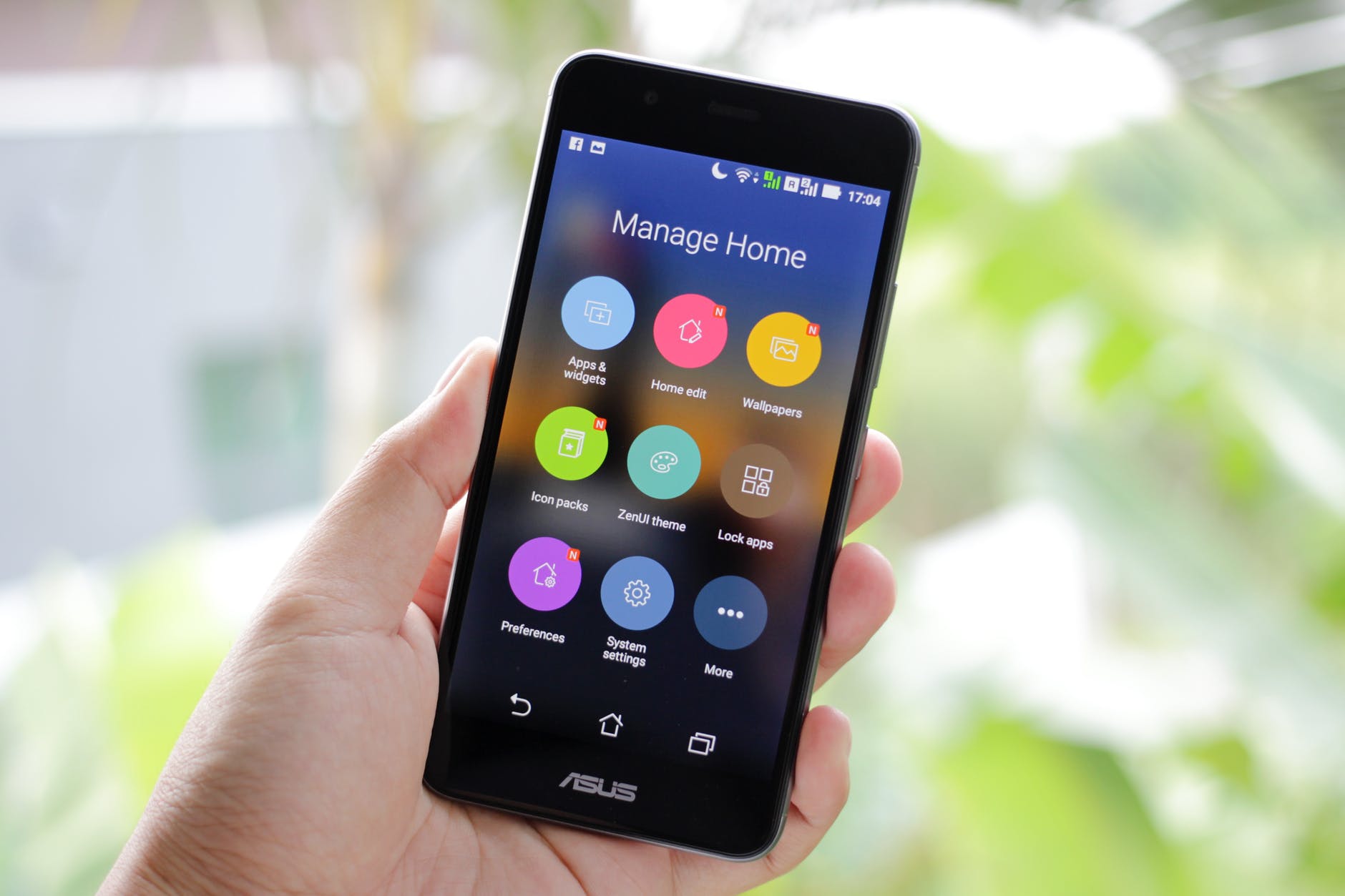
Image: https://www.pexels.com/photo/close-up-of-man-using-mobile-phone-248528/
The Problem
The data contains information regarding mobile phone features, specifications etc and their price range. The various features and information can be used to predict the price range of a mobile phone.
The data features are as follows:
-
Battery Power in mAh
-
Has BlueTooth or not
-
Microprocessor clock speed
-
The phone has dual sim support or not
-
Front Camera Megapixels
-
Has 4G support or not
-
Internal Memory in GigaBytes
-
Mobile Depth in Cm
-
Weight of Mobile Phone
-
Number of cores in the processor
-
Primary Camera Megapixels
-
Pixel Resolution height
-
Pixel resolution width
-
RAM in MB
-
Mobile screen height in cm
-
Mobile screen width in cm
-
Longest time after a single charge
-
3g or not
-
Has touch screen or not
-
Has wifi or not
Methodology
We will proceed with reading the data, and then perform data analysis. The practice of examining data using analytical or statistical methods in order to identify meaningful information is known as data analysis. After data analysis, we will find out the data distribution and data types. We will train 4 classification algorithms to predict the output. We will also compare the outputs. Let us get started with the project implementation.
First, we import the libraries.
import numpy as np # linear algebra import pandas as pd # data processing, CSV file I/O (e.g. pd.read_csv) import seaborn as sns import matplotlib.pylab as plt %matplotlib inline
Now, we read the data and view an overview of the data.
train_data=pd.read_csv('/kaggle/input/mobile-price-classification/train.csv')
train_data.head()
Output:

Now, we will use the info function to see the type of data in the dataset.
train_data.info()
Output:
RangeIndex: 2000 entries, 0 to 1999 Data columns (total 21 columns): # Column Non-Null Count Dtype --- ------ -------------- ----- 0 battery_power 2000 non-null int64 1 blue 2000 non-null int64 2 clock_speed 2000 non-null float64 3 dual_sim 2000 non-null int64 4 fc 2000 non-null int64 5 four_g 2000 non-null int64 6 int_memory 2000 non-null int64 7 m_dep 2000 non-null float64 8 mobile_wt 2000 non-null int64 9 n_cores 2000 non-null int64 10 pc 2000 non-null int64 11 px_height 2000 non-null int64 12 px_width 2000 non-null int64 13 ram 2000 non-null int64 14 sc_h 2000 non-null int64 15 sc_w 2000 non-null int64 16 talk_time 2000 non-null int64 17 three_g 2000 non-null int64 18 touch_screen 2000 non-null int64 19 wifi 2000 non-null int64 20 price_range 2000 non-null int64 dtypes: float64(2), int64(19) memory usage: 328.2 KB
Now, we remove the data points with missing data.
train_data_f = train_data[train_data['sc_w'] != 0] train_data_f.shape
Output:
(1820, 21)
Let us visualize the number of elements in each class of mobile phones.
#classes
sns.set()
price_plot=train_data_f['price_range'].value_counts().plot(kind='bar')
plt.xlabel('price_range')
plt.ylabel('Count')
plt.show()
Output:
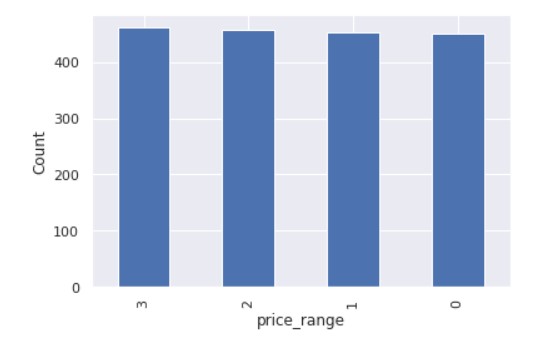
So, there are mobile phones in 4 price ranges. The number of elements is almost similar.
Data Distribution
Let us analyse some data features and see their distribution.
First, we see how the battery mAh is spread.
sns.set(rc={'figure.figsize':(5,5)})
ax=sns.displot(data=train_data_f["battery_power"])
plt.show()
Output:
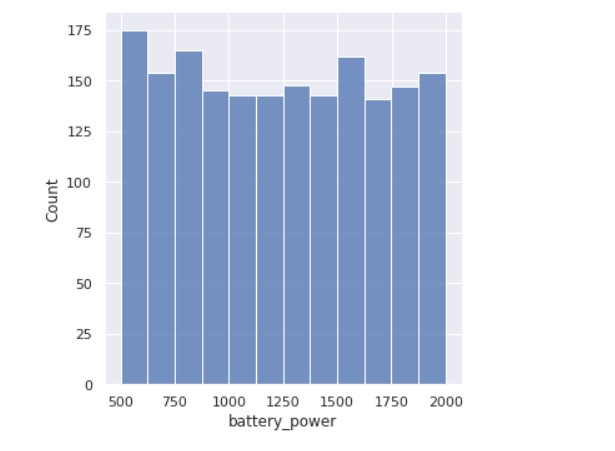
Now, we see the count of how many devices have Bluetooth and how many don’t.
sns.set(rc={'figure.figsize':(5,5)})
ax=sns.displot(data=train_data_f["blue"])
plt.show()
Output:
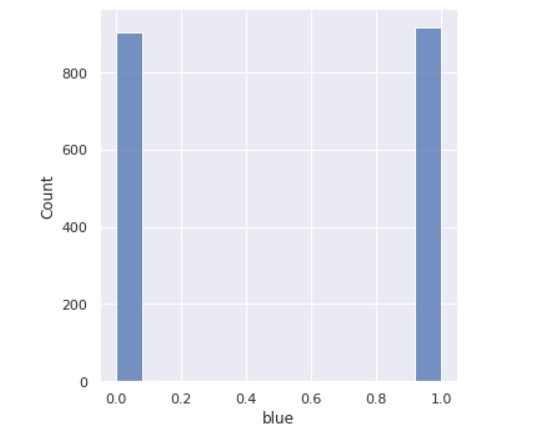
So, we can see that half the devices have Bluetooth, and half don’t.
Next, we analyse the mobile depth ( in cm).
sns.set(rc={'figure.figsize':(5,5)})
ax=sns.displot(data=train_data_f["m_dep"])
plt.show()
Output:
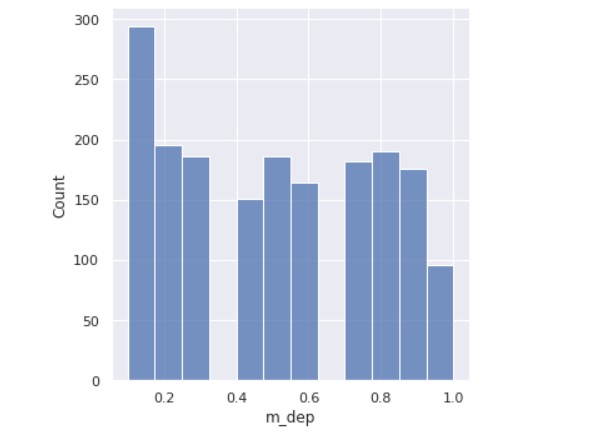
A few mobiles are very thin and a few ones are almost a cm thick.
In a similar way, the data distribution can be analysed for all the data features. Implementing that will be very simple.
Let us see if there are any missing values or missing data.
X=train_data_f.drop(['price_range'], axis=1) y=train_data_f['price_range'] #missing values X.isna().any()
Output:
battery_power False blue False clock_speed False dual_sim False fc False four_g False int_memory False m_dep False mobile_wt False n_cores False pc False px_height False px_width False ram False sc_h False sc_w False talk_time False three_g False touch_screen False wifi False dtype: bool
Let us split the data.
#train test split of data from sklearn.model_selection import train_test_split X_train, X_valid, y_train, y_valid= train_test_split(X, y, test_size=0.2, random_state=7)
Now, we define a function for creating a confusion matrix.
#confusion matrix
from sklearn.metrics import classification_report, confusion_matrix, accuracy_score
def my_confusion_matrix(y_test, y_pred, plt_title):
cm=confusion_matrix(y_test, y_pred)
print(classification_report(y_test, y_pred))
sns.heatmap(cm, annot=True, fmt='g', cbar=False, cmap='BuPu')
plt.xlabel('Predicted Values')
plt.ylabel('Actual Values')
plt.title(plt_title)
plt.show()
return cm
Now, as the function is defined, we can proceed with implementing the classification algorithms.
Random Forest Classifier
A random forest is a supervised machine learning method built from decision tree techniques. This algorithm is used to anticipate behaviour and results in a variety of sectors, including banking and e-commerce.
A random forest is a machine learning approach for solving regression and classification issues. It makes use of ensemble learning, which is a technique that combines multiple classifiers to solve complicated problems.
A random forest method is made up of a large number of decision trees. The random forest algorithm’s ‘forest’ is trained via bagging or bootstrap aggregation. Bagging is a meta-algorithm ensemble that increases the accuracy of machine learning algorithms.
The outcome is determined by the (random forest) algorithm based on the predictions of the decision trees. It forecasts by averaging or averaging the output of several trees. The precision of the outcome improves as the number of trees grows.
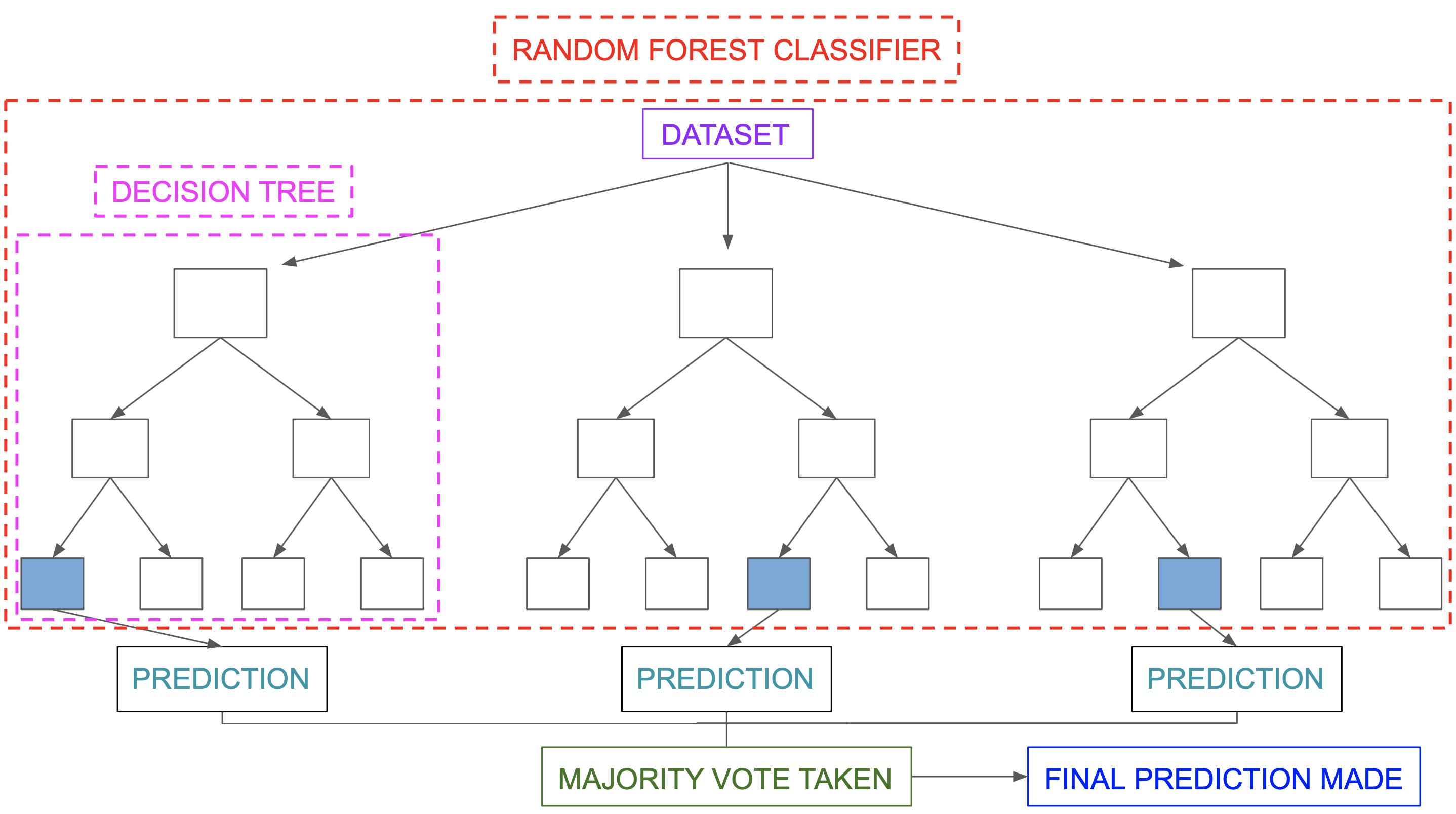
Image Source: https://miro.medium.com/max/5752/1*5dq_1hnqkboZTcKFfwbO9A.png
A random forest system is built on a variety of decision trees. Every decision tree is made up of nodes that represent decisions, leaf nodes, and a root node. The leaf node of each tree represents the decision tree’s final result. The final product is chosen using a majority-voting procedure. In this situation, the output picked by the majority of the decision trees becomes the random forest system’s ultimate output. Let us now implement the random forest algorithm.
First, we build the model.
#building the model
from sklearn.ensemble import RandomForestClassifier
rfc=RandomForestClassifier(bootstrap= True,
max_depth= 7,
max_features= 15,
min_samples_leaf= 3,
min_samples_split= 10,
n_estimators= 200,
random_state=7)
Now, we do the training and prediction.
rfc.fit(X_train, y_train) y_pred_rfc=rfc.predict(X_valid)
Let us apply the function for the accuracy metrics.
print('Random Forest Classifier Accuracy Score: ',accuracy_score(y_valid,y_pred_rfc))
cm_rfc=my_confusion_matrix(y_valid, y_pred_rfc, 'Random Forest Confusion Matrix')
Output:
Random Forest Classifier Accuracy Score: 0.9093406593406593
precision recall f1-score support
0 0.98 0.97 0.97 95
1 0.90 0.92 0.91 92
2 0.82 0.86 0.84 86
3 0.93 0.88 0.90 91
accuracy 0.91 364
macro avg 0.91 0.91 0.91 364
weighted avg 0.91 0.91 0.91 364
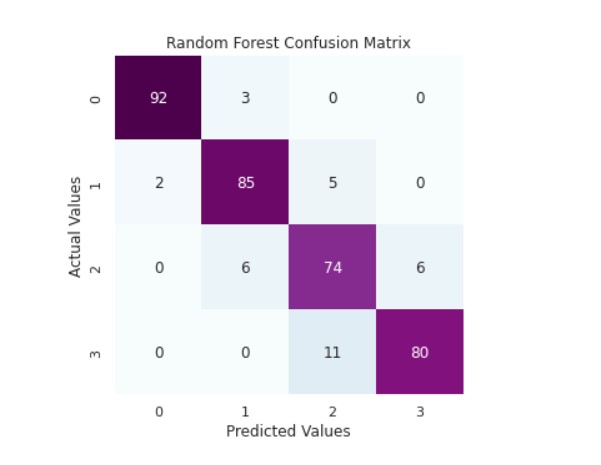
So, we can see that the random forest algorithm has good accuracy in prediction.
Naive Bayes
Conditional probability is the foundation of Bayes’ theorem. The conditional probability aids us in assessing the likelihood of something occurring if something else has previously occurred.
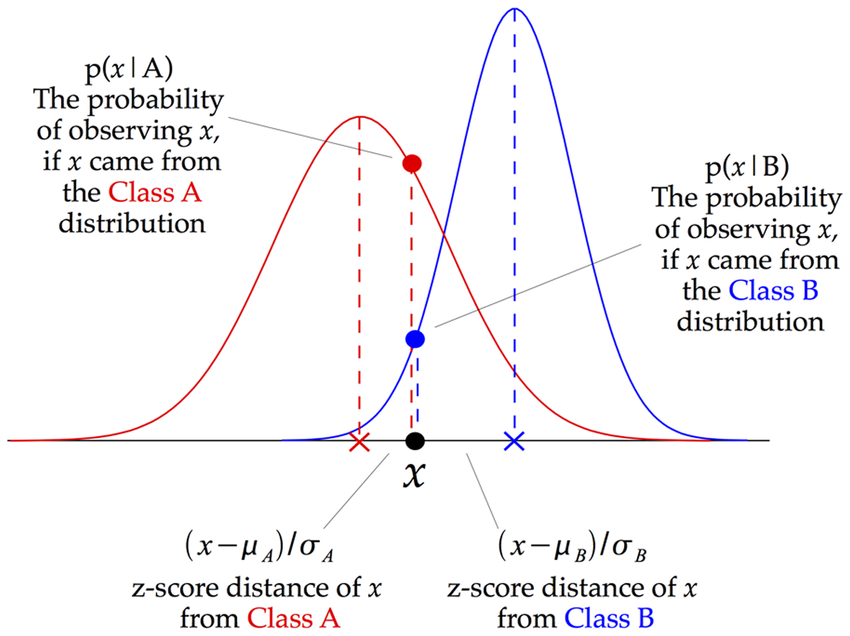
Image: Illustration of how a Gaussian Naive Bayes (GNB) classifier works
Source: https://www.researchgate.net/figure/Illustration-of-how-a-Gaussian-Naive-Bayes-GNB-classifier-works-For-each-data-point_fig8_255695722
Gaussian Naive Bayes is a Naive Bayes variation that allows continuous data and follows the Gaussian normal distribution. The Bayes theorem is the foundation of a family of supervised machine learning classification algorithms known as naive Bayes. It is a basic categorization approach with a lot of power. When the dimensionality of the inputs is high, they are useful. The Naive Bayes Classifier may also be used to solve complex classification issues.
Let us implement the Gaussian NB classifier.
from sklearn.naive_bayes import GaussianNB gnb = GaussianNB()
Now, we perform the training and prediction.
gnb.fit(X_train, y_train) y_pred_gnb=gnb.predict(X_valid)
Now, we can check the accuracy.
print('Gaussian NB Classifier Accuracy Score: ',accuracy_score(y_valid,y_pred_gnb))
cm_rfc=my_confusion_matrix(y_valid, y_pred_gnb, 'Gaussian NB Confusion Matrix')
Output:
Gaussian NB Classifier Accuracy Score: 0.8461538461538461
precision recall f1-score support
0 0.93 0.92 0.92 95
1 0.79 0.73 0.76 92
2 0.74 0.80 0.77 86
3 0.92 0.93 0.93 91
accuracy 0.85 364
macro avg 0.84 0.85 0.84 364
weighted avg 0.85 0.85 0.85 364
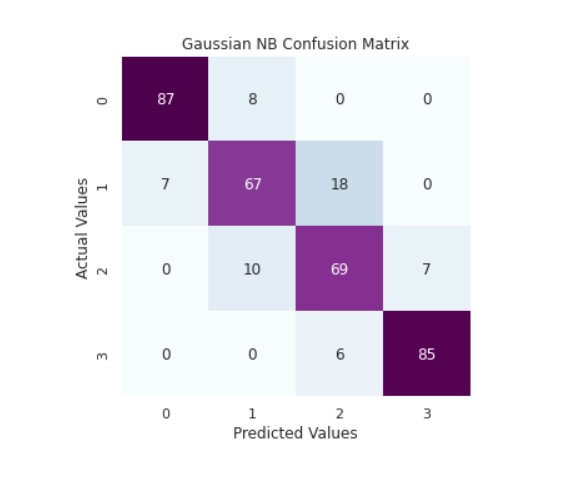
We can see that the model is performing well.
KNN Classifier
The K Nearest Neighbor method is a type of supervised learning technique that is used for classification and regression. It’s a flexible approach that may also be used to fill in missing values and resample datasets. K Nearest Neighbor examines K Nearest Neighbors (Data points) to forecast the class or continuous value for a new Datapoint, as the name indicates.
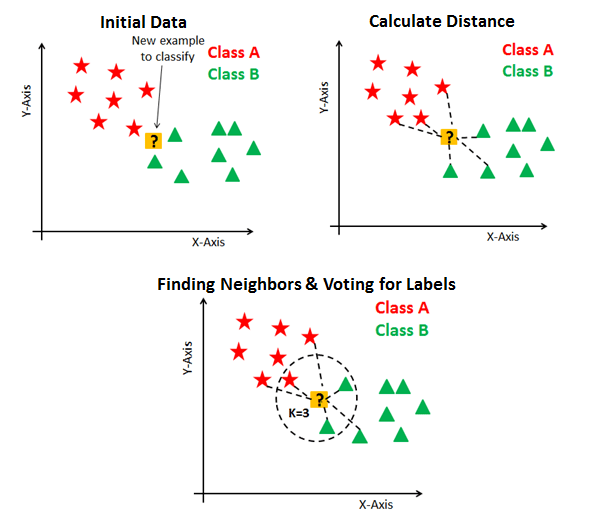
Image: https://blakelobato1.medium.com/k-nearest-neighbor-classifier-implement-homemade-class-compare-with-sklearn-import-6896f49b89e
The K-NN method saves all available data and classifies a new data point based on its similarity to the existing data. This implies that fresh data may be quickly sorted into a well-defined category using the K-NN method. The K-NN algorithm is a non-parametric algorithm, which means it makes no assumptions about the underlying data. It’s also known as a lazy learner algorithm since it doesn’t learn from the training set right away; instead, it saves the dataset and performs an action on it when it comes time to classify it.
Let us perform the implementation of the classifier.
from sklearn.neighbors import KNeighborsClassifier knn = KNeighborsClassifier(n_neighbors=3,leaf_size=25)
Now, we train the data and make our predictions.
knn.fit(X_train, y_train) y_pred_knn=knn.predict(X_valid)
Now, we check the accuracy.
print('KNN Classifier Accuracy Score: ',accuracy_score(y_valid,y_pred_knn))
cm_rfc=my_confusion_matrix(y_valid, y_pred_knn, 'KNN Confusion Matrix')
Output:
KNN Classifier Accuracy Score: 0.9340659340659341
precision recall f1-score support
0 0.99 0.98 0.98 95
1 0.93 0.97 0.95 92
2 0.87 0.88 0.88 86
3 0.94 0.90 0.92 91
accuracy 0.93 364
macro avg 0.93 0.93 0.93 364
weighted avg 0.93 0.93 0.93 364
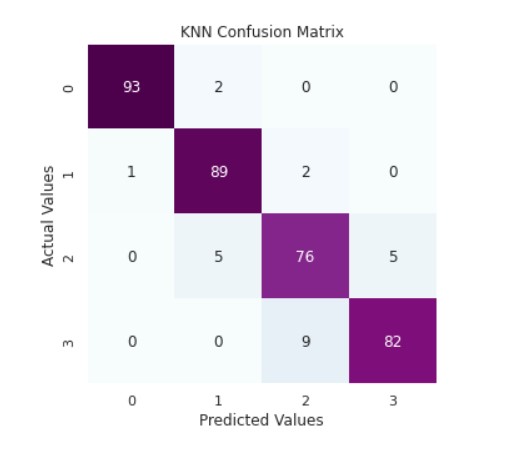
The KNN classifier is quite adept at its task.
SVM Classifier
Support Vector Machine, or SVM, is a prominent Supervised Learning technique that is used for both classification and regression issues. However, it is mostly utilised in Machine Learning for Classification purposes.
The SVM algorithm’s purpose is to find the optimum line or decision boundary for categorising n-dimensional space so that we may simply place fresh data points in the proper category in the future. A hyperplane is the optimal choice boundary.
Check this article for more information on SVM.
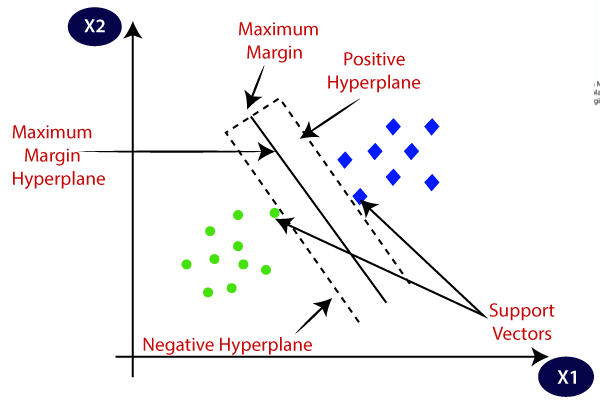
Image: https://www.javatpoint.com/machine-learning-support-vector-machine-algorithm
Let us do the implementation of SVM.
from sklearn import svm svm_clf = svm.SVC(decision_function_shape='ovo')
svm_clf.fit(X_train, y_train) y_pred_svm=svm_clf.predict(X_valid)
Now, we check the accuracy.
print('SVM Classifier Accuracy Score: ',accuracy_score(y_valid,y_pred_svm))
cm_rfc=my_confusion_matrix(y_valid, y_pred_svm, 'SVM Confusion Matrix')
Output:
SVM Classifier Accuracy Score: 0.9587912087912088
precision recall f1-score support
0 0.98 0.98 0.98 95
1 0.93 0.97 0.95 92
2 0.94 0.93 0.94 86
3 0.99 0.96 0.97 91
accuracy 0.96 364
macro avg 0.96 0.96 0.96 364
weighted avg 0.96 0.96 0.96 364
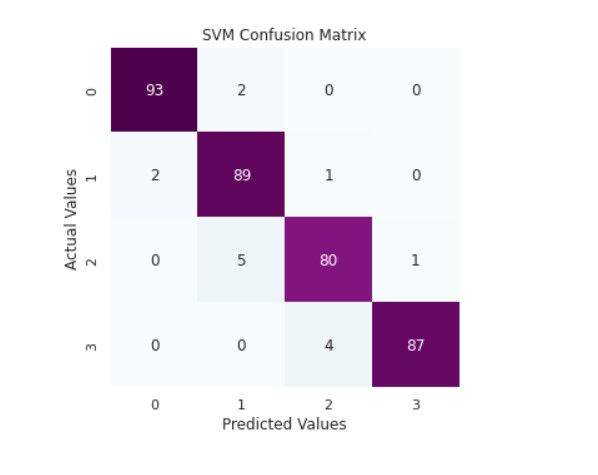
We can see that the SVM classifier is giving the best accuracy.
Link to the code: https://www.kaggle.com/prateekmaj21/mobile-price-prediction
Conclusion
In this article, we looked at classification. Classifiers represent the intersection of advanced machine theory and practical application. These algorithms are more than just a sorting mechanism for organising unlabeled data instances into distinct groupings. Classifiers include a unique set of dynamic rules that include an interpretation mechanism for dealing with ambiguous or unknown values, all of which are suited to the kind of inputs being analysed. Most classifiers also utilise probability estimates, which enable end-users to adjust data categorization using utility functions.
The media shown in this article is not owned by Analytics Vidhya and are used at the Author’s discretion.








At the end of the year and the beginning of this year, the inevitability of an increase in the cost of electronics became inevitable, and in each of the segments. Some products in 2022-2023 will grow by tens of percent, somewhere the growth will be 50-100%, as it will be regulated by various factors. The smartphone market has always been in the best position: aggressive competition between Samsung and Chinese manufacturers, burning profits from Chinese players, and fighting for the legacy of Huawei/Honor, who have lost ground. All this played into the hands of buyers, as growth was offset by discounts, marketing campaigns and an attempt to capture market share. Until mid-March, prices will remain more or less stable, they will not increase, and there will even be good discounts that you need to use.
how i can insert the predicted values in the data table? we deleted the colum price_range to get the prediction numbers but how tkae this to subtituite the deleted column?